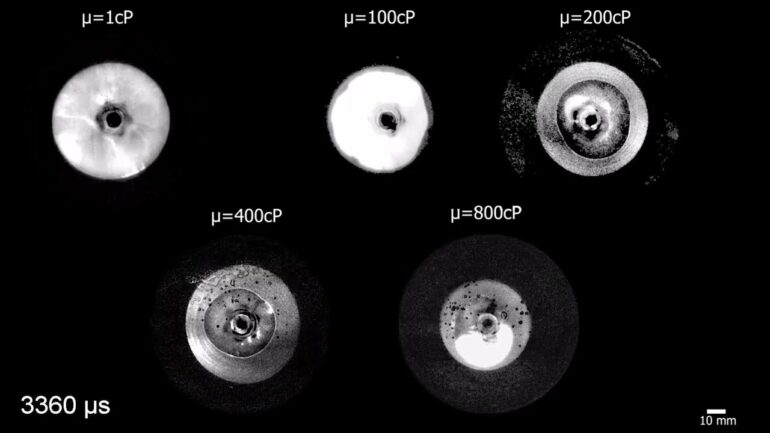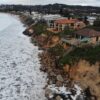Here’s a moment that almost everyone has experienced—you drop your phone screen down on a hard surface and hear the telltale crunch. The screen is cracked but you don’t know how bad. You pick up the phone and survey the damage.
At that moment, looking at your cracked phone screen, have you ever wondered why it cracked in the way it did? Why do some fault lines stretch across the screen while others stop after only a few millimeters?
Harvard scientists, in collaboration with an international and interdisciplinary team of researchers, are exploring how cracks start, propagate and end. Their findings, detailed in papers published in Nature Physics and AGU Advances, provide a deeper understanding of the lifecycle of fractures and could improve our understanding of material science, earthquakes, and production of geothermal energy, oil, and gas.
The research represents a collaboration between material scientists and engineers and geophysicists and seismologists.
“We began this research exploring fracturing for its applications but we quickly came to realize that there is so much more to the mechanics and dynamics of fractures than we initially thought,” said Thomas Cochard, a postdoctoral fellow at the Harvard John A. Paulson School of Engineering and Applied Sciences and author of the papers. “We came to this topic from an engineering and applications perspective and ended up doing fundamental fracture research.”
The life cycle of a crack
Hydraulic fracturing, known as fracking, is the process of creating fractures in rocks by injecting pressurized fluids into the ground to generate a network of connected cracks. This process, widely used for oil and gas recovery or geothermal energy, is also observed in nature, for example, in the formation of magmatic dikes.
Initially, the research team led by David A. Weitz, the Mallinckrodt Professor of Physics and of Applied Physics at SEAS, wanted to better understand how natural rocks fracture during hydraulic fracturing.
The team included researchers from the China University of Petroleum (Beijing), University of Nottingham, Tufts University, the University of Washington, and the Hebrew University of Jerusalem.
“Fracturing is well understood in two dimensions but more realistic fractures in complex, three-dimensional materials present a plethora of complex behaviors which are widely studied yet remain poorly understood at a fundamental level,” said Weitz, senior author on both papers.
To understand fractures in three dimensions, the team introduced a crack in a transparent material, and then injected liquids of varying viscosities. Using a high-speed camera that can capture 100,000 images per second with a spatial resolution of a couple of micrometers and cutting-edge acoustic emission sensors, the team was able to visualize and listen to the dynamics of fractures as they spread through the material.
The team found that rather than moving through a material like a continuous wave, fractures move in starts and stops, propagating from their origin in a material outward through a series of high-speed jumps.
“It’s a really dynamic process,” said Cochard. “A new crack forms somewhere along the stalled front line of the fracture, locally distorting it, causing the expansion of the crack at the speed of sound in the direction of the fracture line and then the fluid follows. The crack stops, the fluid penetrates inducing a stress at the fracture front where a new crack starts over again following the same dynamics.”
The team found that the amplitude and the time between these jumps depends on the viscosity of the liquid. With low viscosity liquids, like water, the time between jumps is miniscule as the fluid penetrates the crack almost instantaneously. With higher viscosity fluids, like glycerol, which has viscosity similar to honey, the lag between the so-called fracture front (where the crack is) and the fluid front (where the liquid tip is) increases as it takes longer for the high-viscosity fluid to penetrate the crack and expand it.
In addition to experiments, the team also developed a numerical model.
“Our numerical model builds on the same mathematical equations and assumptions of fracture theory, but is fully three dimensional,” said Gabriele Albertini, Assistant Professor at the University of Nottingham and co-author of the study. “We discovered that the simulation was able to reproduce the experimental data in a quantitative manner, with no fitting parameters. This emphasizes the generality of our finding, which is applicable to fractures that arise in a wide range of scenarios and not just in the specific case of a fluid-driven crack.”
Cracking the mechanisms of earthquakes
Using that same experimental set-up, the researchers turned their attention to earthquakes—which, after all, are caused by fractures in tectonic plates. Specifically, the team looked at slow slip and tectonic tremor, also known as slow earthquakes.
“Slow earthquakes are very interesting and important because they could potentially trigger big earthquakes, although they move slowly compared to regular earthquakes,” said Congcong Yuan, a graduate student in Earth and Planetary Sciences at Harvard and first author of the AGU Advances paper. “Previous studies have observed that fluids can play a role in regulating slow slip and tectonic tremor events but how hydrofractures regulate fluid flow and interact with shear cracks has not been understood.”
Yuan and the team, which included researchers from the China University of Petroleum, the University of Washington and the U.S. Geological Survey, found that hydraulic fractures, also known as tensile cracks, play a major role in the generation of tectonic tremors.
The team simulated slow earthquakes by introducing a crack in a material by injecting fluid and using slow-motion videos and acoustic emissions to map the propagation of cracks. The start/stop fracture dynamics observed in the experiments were similar to real-world observations of tectonic tremors in the Cascadia region of the United States.
Evidence of hydraulic fracturing can also be found in the geological record of rock outcrops from the depth of tectonic tremors.
“Building off previous studies, our work proposes that tectonic tremors may not solely be shear slips between two plates but could also be caused by hydraulic fractures, which promote fluid transport and overall shear slips,” said Yuan.
“It’s exciting to see a new demonstration of how the tectonic tremors we observe at the surface could be deep hydraulic fractures,” said co-author Marine Denolle, who began advising Yuan’s work when she was an Assistant Professor in the Department of Earth and Planetary Sciences at Harvard. “As geophysicists, we just assume that the tectonic movements are shear. But we show experimentally that hydraulic fracture is consistent with the geological record.” Denolle is now an Assistant Professor at the University of Washington.
“This is the first, comprehensive, lab-based study of how fluid regulates tectonic tremors,” said Weitz.
“Taken together, these two papers reflect the collaboration and advances spurred by two research fields—material sciences and earthquake sciences,” said Denolle.
More information:
T. Cochard et al, Propagation of extended fractures by local nucleation and rapid transverse expansion of crack-front distortion, Nature Physics (2024). DOI: 10.1038/s41567-023-02365-0
C. Yuan et al, Laboratory Hydrofractures as Analogs to Tectonic Tremors, AGU Advances (2024). DOI: 10.1029/2023AV001002
Provided by
Harvard John A. Paulson School of Engineering and Applied Sciences
Citation:
Researchers explore how fractures nucleate, propagate and stop (2024, January 29)



